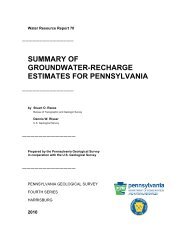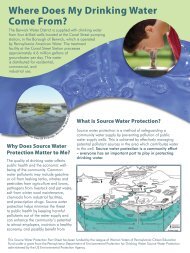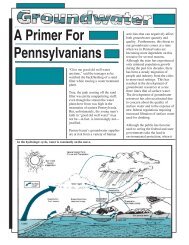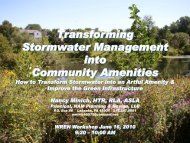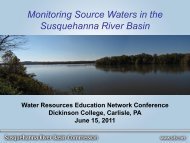NITROGEN POLLUTION: - Hubbard Brook Research Foundation
NITROGEN POLLUTION: - Hubbard Brook Research Foundation
NITROGEN POLLUTION: - Hubbard Brook Research Foundation
Create successful ePaper yourself
Turn your PDF publications into a flip-book with our unique Google optimized e-Paper software.
Experimental Forest that receive lower amounts of nitrogen from atmospheric<br />
deposition would reach the 8 kg N/ha-yr target with lower emission reductions.<br />
3. The 1990 CAAAs will not reduce emissions and deposition of acid compounds<br />
(such as nitric acid) enough to completely mitigate adverse chemical conditions<br />
associated with acid rain at the Biscuit <strong>Brook</strong> or <strong>Hubbard</strong> <strong>Brook</strong> watersheds.<br />
4. Under the most aggressive scenario that cuts total nitrogen emissions in the<br />
airshed by 50 percent from current levels, the targets for chemical recovery<br />
from acid rain are not reached at <strong>Hubbard</strong> <strong>Brook</strong> within 50 years. However,<br />
substantial improvements do occur, demonstrating that the emission reductions<br />
would have beneficial effects. At Biscuit <strong>Brook</strong>, the aggressive nitrogen<br />
scenario would achieve some of the targets by 2050, including stream pH<br />
(acidity). The slow recovery from acid rain in both watersheds is related to<br />
the fact that sulfur dioxide is also a large component of acid rain.<br />
5. When cuts in sulfur dioxide emissions from electric utilities of 75 percent<br />
beyond the 1990 CAAAs are considered with nitrogen reductions, it is predicted<br />
that the Biscuit <strong>Brook</strong> watershed would reach nearly full chemical recovery by<br />
2050. The rate of improvement at <strong>Hubbard</strong> <strong>Brook</strong> would increase markedly<br />
under this option.<br />
6. The PnET-BGC model results suggest that sensitive forest ecosystems would<br />
require substantial reductions in nitrogen and sulfur emissions beyond the 1990<br />
CAAAs in order to mitigate ecosystem stress due to acidic and reactive nitrogen<br />
inputs within 50 years.<br />
Reductions in NO x<br />
emissions are particularly important in reducing stream nitrate<br />
concentrations during spring, fall and winter when stream nitrate concentrations and<br />
acidity are highest. Another analysis using PnET-BGC shows that proposed<br />
reductions in NO x<br />
emissions that are limited to the summer ozone season would not<br />
decrease stream nitrate concentrations much over the short-term. Year-round controls<br />
would be more effective in reducing the total nitrogen load and elevated nitrate<br />
concentrations during the non-growing season over the long-term (Gbondo-Tugbawa<br />
and Driscoll 2002).<br />
What are the most effective strategies for reducing<br />
nitrogen pollution to estuaries<br />
Nitrogen removal from wastewater at a basin-wide scale is the single most<br />
effective means of reducing nitrogen loading to estuaries in the Northeast.<br />
The U.S. Clean Water Act and Safe Drinking Water Act set water quality standards<br />
for nitrogen in surface waters and groundwater. These standards provide the basis for<br />
regulatory programs implemented by the U.S. EPA. Water quality standards for nitrogen<br />
pollution include standards to protect human health, drinking water and aquatic life.<br />
States are allowed to establish more stringent water quality standards, but must enforce<br />
the federal standards at a minimum.<br />
The federal standards establish a concentration limit for specific forms of nitrogen<br />
in surface waters. However, there is currently no water quality standard that limits<br />
the total loading of reactive nitrogen to surface waters. If excess nitrogen causes<br />
violations of other water quality standards (such as dissolved oxygen), state agencies<br />
are required to develop a U.S. EPA-approved plan to address the reactive nitrogen<br />
loading. The plan, known as a Total Maximum Daily Load (TMDL) plan, must specify<br />
the pollutant loading levels from all contributing sources that can be allowed and<br />
still attain water quality standards. In 2001, the states of Connecticut and New York<br />
adopted a TMDL plan to address chronic dissolved oxygen problems in Long Island<br />
Sound by reducing reactive nitrogen loading to the estuary 38 percent by 2014.<br />
Most of the nitrogen reductions will come from Connecticut and New York, where<br />
a 58.5 percent reduction target has been established.<br />
PAGE 20



